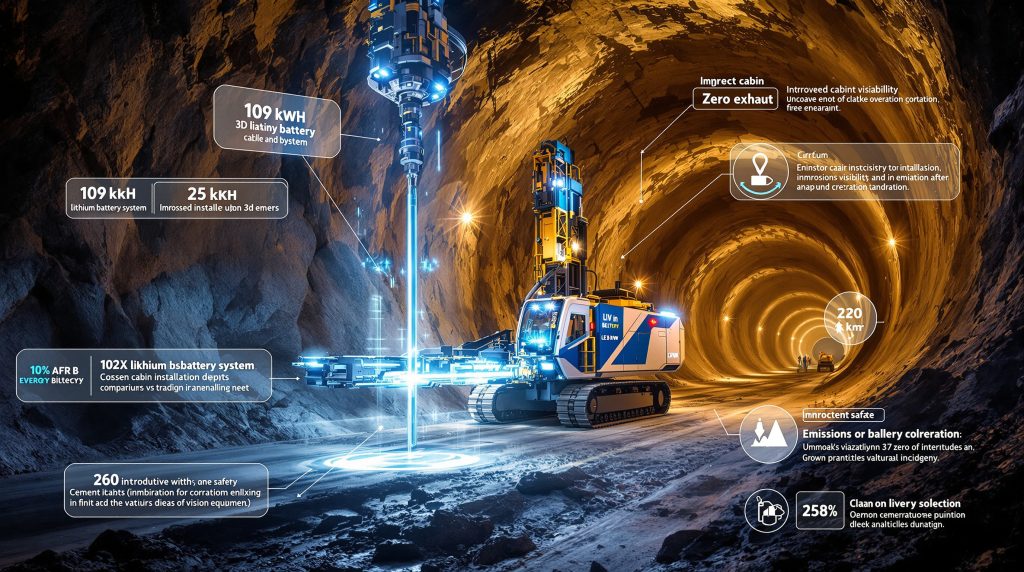The underground mining industry is witnessing a revolutionary transformation with the introduction of battery-powered cable bolters, representing a fundamental departure from traditional diesel-powered equipment. These innovative machines combine the essential functions of drilling, grouting, and cable installation into a single electric platform. Furthermore, they eliminate the combustion engines that have long dominated underground environments while incorporating advanced battery recycling breakthrough technologies.
The core functionality centres on installing cement-grouted cable reinforcement systems using advanced battery-electric power sources. This technology represents more than simply replacing diesel engines with batteries; it involves comprehensive redesign of power distribution, operational workflows, and safety protocols. In addition, the integration of electric drive systems enables precise control over drilling parameters while maintaining the robust performance required for challenging underground conditions.
Defining Modern Cable Bolting Systems
Battery-powered cable bolters serve as specialised rock reinforcement equipment designed specifically for underground mining and tunnel construction applications. These systems differ significantly from surface drilling equipment, incorporating features essential for confined space operations. Consequently, they include enhanced ventilation compatibility, reduced emissions, and improved operator safety protocols.
The primary distinction from conventional equipment lies in the complete elimination of combustion-based power generation. Traditional cable bolters rely on diesel engines not only for mobility but also for powering hydraulic systems, drilling mechanisms, and auxiliary equipment. However, battery-electric alternatives distribute power through sophisticated electrical systems that provide consistent performance across varying operational conditions.
Modern cable bolting operations require precise installation of reinforcement systems extending deep into rock formations. The equipment must deliver sufficient power for drilling through diverse geological conditions while maintaining the mobility necessary for underground navigation. Furthermore, battery-electric systems meet these demands through advanced motor technologies that provide superior torque characteristics compared to combustion engines.
The Technology Behind Battery-Electric Operation
Advanced battery technologies enable these systems to operate effectively in demanding underground environments. Lithium batteries revolution developments have evolved to provide the energy density and discharge characteristics necessary for heavy-duty mining applications. These power sources deliver consistent voltage and current throughout extended operational cycles, ensuring reliable performance regardless of ambient temperature or elevation changes.
The integration of electric drive systems transforms traditional mechanical power transmission into sophisticated electronic control networks. This technological approach enables precise management of drilling speed, torque application, and hydraulic system pressure through digital interfaces. For instance, operators benefit from enhanced control capabilities that were previously unavailable with mechanical transmission systems.
Electric motor systems provide instantaneous torque delivery, enabling improved drilling performance in challenging geological conditions. The elimination of engine warm-up periods and the consistent power delivery characteristics of electric systems reduce operational delays. Consequently, these performance advantages become particularly significant in underground environments where equipment efficiency directly impacts ventilation requirements and operational costs.
Zero-Emission Underground Operations
The transition to battery-powered cable bolters fundamentally addresses air quality challenges that have long plagued underground mining operations. Diesel combustion in confined spaces creates complex ventilation requirements, heat management issues, and worker health concerns. However, these factors significantly impact operational efficiency and safety protocols.
Battery-electric systems eliminate tailpipe emissions entirely, removing particulate matter, nitrogen oxides, carbon monoxide, and other combustion byproducts from underground environments. This emission elimination reduces ventilation requirements, potentially decreasing infrastructure costs and improving overall air quality for underground workers. Moreover, renewable energy solutions can power these systems for complete sustainability.
Heat generation represents another critical advantage of electric systems. Combustion engines convert significant portions of fuel energy into waste heat, requiring additional ventilation capacity to maintain acceptable working temperatures. In contrast, electric motors operate with higher efficiency rates, converting more input energy into useful work while generating substantially less waste heat.
Enhanced Operator Protection Features
Modern battery-powered cable bolters incorporate advanced safety features designed to minimise operator exposure to hazardous conditions. Remote operation capabilities enable personnel to maintain safe distances from unstable ground conditions during cable installation procedures. These systems utilise wireless control interfaces and automated positioning systems to reduce direct human involvement in high-risk activities.
Improved visibility represents a significant safety enhancement in underground operations. Electric systems eliminate exhaust emissions that can obscure operator vision, while advanced lighting systems powered by the main battery pack provide superior illumination. Enhanced visibility contributes to safer navigation and more precise equipment positioning in confined underground spaces.
Automated safety systems integrated into battery-electric platforms provide real-time monitoring of operational parameters and environmental conditions. These systems can detect potentially dangerous situations and implement protective measures automatically. Furthermore, they reduce reliance on operator judgement in high-stress situations whilst emergency shutdown capabilities and fail-safe mechanisms further enhance operator protection during critical operations.
Technical Capabilities and Performance Parameters
Battery-powered cable bolters demonstrate impressive technical capabilities that match or exceed traditional diesel-powered alternatives across multiple performance metrics. These systems integrate sophisticated technologies to deliver reliable operation in demanding underground conditions while providing enhanced operational flexibility. Additionally, AI transforming drilling processes further enhances their capabilities.
| Performance Category | Capability Range | Operational Impact |
|---|---|---|
| Operating Duration | Extended shift coverage | Reduced charging interruptions |
| Power Delivery | Consistent across conditions | Improved drilling efficiency |
| Maintenance Requirements | Simplified service intervals | Lower operational costs |
| Environmental Impact | Zero direct emissions | Enhanced air quality |
The technical architecture of modern battery-powered cable bolters encompasses multiple integrated systems working in coordination. Power management systems optimise energy distribution across drilling, tramming, and auxiliary functions to maximise operational efficiency. Advanced battery management systems monitor cell performance, temperature, and charge status to ensure reliable operation throughout demanding work cycles.
Automation and Digital Integration
Contemporary battery-powered cable bolters incorporate sophisticated automation capabilities that enhance installation consistency and reduce operator workload. Automated drilling sequences ensure precise hole placement and consistent installation parameters across multiple cable bolt installations. These systems utilise programmable control interfaces that operators can customise for specific geological conditions and installation requirements.
Digital connectivity enables integration with mine-wide information systems, providing real-time operational data and performance analytics. Fleet management capabilities allow mining operations to monitor equipment utilisation, maintenance requirements, and operational efficiency across multiple units simultaneously. This data integration supports optimised deployment strategies and predictive maintenance programmes.
Real-time monitoring systems track critical operational parameters including battery status, drilling performance, and cement handling efficiency. Advanced diagnostic capabilities provide early warning of potential maintenance requirements, enabling proactive service scheduling that minimises operational disruptions. These monitoring systems contribute to improved equipment reliability and reduced total cost of ownership.
Operational Efficiency Advantages of Electric Systems
Battery-electric cable bolters demonstrate superior operational characteristics compared to traditional diesel-powered alternatives across multiple performance dimensions. The fundamental differences in power delivery and system design create measurable advantages in productivity, reliability, and operational flexibility. For instance, Sandvik's world-first battery-powered cable bolter exemplifies these technological advances.
Electric motor systems provide immediate maximum torque upon startup, eliminating the power buildup delays associated with combustion engines. This characteristic proves particularly valuable in underground operations where frequent starts and stops are common. The instant power availability reduces cycle times and improves overall productivity in cable installation operations.
Consistent power output represents another significant advantage of electric systems. Diesel engines experience power variations based on altitude, temperature, and maintenance conditions, while electric systems maintain consistent performance characteristics across varying environmental conditions. This consistency translates to predictable drilling performance and more reliable installation timelines.
Economic Benefits Analysis
The economic advantages of battery-electric cable bolters extend beyond simple fuel cost savings to encompass multiple operational and infrastructure considerations. Reduced ventilation requirements in underground operations can significantly impact infrastructure costs, particularly in deep mines where air circulation represents a major operational expense. Furthermore, battery-grade lithium investments continue to improve economic viability.
Energy costs for electric systems typically demonstrate favourable economics compared to diesel fuel, particularly in regions with abundant renewable energy resources. The efficiency advantages of electric motors over combustion engines amplify these cost benefits, as more input energy converts to useful work rather than waste heat.
Maintenance requirements for electric systems generally involve fewer components and less frequent service intervals compared to combustion engines. The elimination of engine oil changes, fuel system maintenance, and exhaust system service reduces both direct maintenance costs and equipment downtime. Extended component lifecycles contribute to improved total cost of ownership over typical equipment lifecycles.
"Economic Consideration: Total cost of ownership calculations must account for initial capital investment, energy costs, maintenance requirements, and infrastructure modifications when evaluating battery-electric alternatives to diesel systems."
Cement Handling and Automation Systems
Advanced cement handling capabilities integrated into battery-powered cable bolters streamline installation procedures while improving grout quality consistency. These systems automate traditionally manual processes, reducing labour requirements and minimising installation variability that can compromise reinforcement effectiveness. Additionally, Industry Queensland reports highlight significant productivity improvements.
Automated cement mixing systems utilise programmable controllers to maintain precise water-to-cement ratios throughout installation procedures. This consistency ensures optimal grout properties for each cable bolt installation, improving the reliability of rock reinforcement systems. Automated mixing eliminates human error in proportion control while reducing material waste through precise measurement capabilities.
Integrated cement storage and handling systems reduce the frequency of material replenishment operations, enabling extended periods of continuous installation work. Onboard storage capacity must balance material availability with equipment mobility requirements in confined underground spaces. Advanced material handling systems optimise this balance through efficient loading mechanisms and strategic storage configurations.
Workflow Optimisation Features
Modern cement handling systems integrate with drilling and installation sequences to create seamless operational workflows. Automated coordination between drilling completion and grout injection reduces installation cycle times while ensuring proper grout placement. These integrated systems minimise the potential for installation defects that can occur with manual coordination of multiple operational steps.
Quality control systems monitor grout consistency, injection pressure, and installation parameters throughout each cable bolt installation. Real-time monitoring enables immediate detection of potential installation issues, allowing operators to make corrections before completing individual installations. This quality assurance capability improves overall reinforcement system reliability.
Streamlined logistics result from reduced dependency on external support equipment for cement preparation and handling. Self-contained cement systems reduce traffic in underground areas while eliminating coordination requirements with separate mixing equipment. This operational independence improves scheduling flexibility and reduces potential conflicts with other underground activities.
Addressing Traditional Mining Equipment Limitations
Battery-powered cable bolters directly address several persistent challenges associated with traditional diesel-powered equipment in underground environments. These limitations have historically imposed significant operational constraints and safety concerns that impact mining productivity and worker welfare. Furthermore, they create substantial ventilation and heat management challenges.
Diesel exhaust accumulation in underground spaces requires extensive ventilation systems to maintain acceptable air quality standards. The volume of fresh air required to dilute diesel emissions often exceeds what natural ventilation can provide, necessitating expensive mechanical ventilation systems. Eliminating diesel emissions reduces these ventilation requirements, potentially enabling operations in areas where ventilation constraints previously limited activities.
Heat generation from diesel engines compounds ventilation challenges by increasing the thermal load that ventilation systems must manage. Underground temperatures naturally increase with depth, and additional heat from equipment can create uncomfortable or dangerous working conditions. Electric systems generate significantly less waste heat, reducing thermal management requirements and improving working conditions.
Infrastructure and Logistics Improvements
Battery-electric systems reduce dependency on fuel supply chains that can be complex and expensive in remote mining locations. Fuel transportation, storage, and handling requirements impose logistical burdens that electric systems eliminate. Underground fuel storage requires specialised infrastructure and safety protocols that add complexity to mining operations.
Simplified maintenance requirements for electric systems reduce inventory needs for spare parts and consumables. Diesel engines require multiple fluid types, filters, and wear components that electric systems do not need. This simplification reduces inventory carrying costs and storage space requirements while simplifying maintenance training requirements.
Enhanced operational flexibility results from the elimination of fuel consumption constraints. Electric systems can operate without concern for fuel availability during extended shifts or in remote areas where fuel resupply is challenging. Battery charging can often utilise existing electrical infrastructure, reducing dependency on specialised fuel delivery systems.
Optimal Application Scenarios for Battery Cable Bolters
Certain mining operations demonstrate particularly strong alignment with the capabilities and advantages of battery-powered cable bolters. Understanding these optimal application scenarios enables mining companies to evaluate the technology's potential benefits within their specific operational contexts. For instance, deep underground operations particularly benefit from emission-free equipment.
Deep underground mines with limited natural ventilation capacity represent ideal applications for battery-electric equipment. As mining operations extend to greater depths, ventilation requirements increase exponentially while ventilation effectiveness decreases. Eliminating diesel emissions can significantly reduce ventilation requirements, enabling deeper operations or reducing ventilation infrastructure costs.
Operations with stringent environmental regulations or corporate sustainability commitments benefit substantially from zero-emission equipment. Mining companies increasingly face regulatory pressure to reduce emissions and demonstrate environmental responsibility. Battery-electric equipment provides measurable emission reductions that support compliance efforts and corporate environmental goals.
Integration with Existing Mine Systems
Battery-powered cable bolters can integrate with established mining operations without requiring fundamental changes to rock reinforcement protocols or installation procedures. The basic cable bolt installation process remains unchanged, while the power source and emission profile improve significantly. This compatibility enables gradual fleet transitions without disrupting established operational procedures.
Maintenance integration with existing programmes requires consideration of different skill sets and spare parts requirements for electric systems. While electric systems generally require less maintenance, the maintenance tasks differ from those required for diesel equipment. Training programmes and inventory adjustments support successful integration with established maintenance operations.
Scalability considerations enable mining operations to implement battery-electric technology gradually, evaluating performance and benefits before committing to fleet-wide transitions. Pilot implementations provide valuable operational experience and economic data to support broader deployment decisions. This approach minimises implementation risks while maximising learning opportunities.
Supporting Future Mining Industry Trends
Battery-powered cable bolters align with several significant trends transforming the mining industry, positioning adopting operations at the forefront of technological and regulatory developments. These trends represent both opportunities and challenges that forward-thinking mining companies must address to remain competitive. Additionally, they support comprehensive sustainability strategies.
Environmental compliance requirements continue to tighten across mining jurisdictions worldwide, with particular emphasis on emission reduction and air quality improvement. Battery-electric equipment provides a proven pathway to meet current and anticipated future environmental standards while maintaining operational effectiveness. Early adoption positions mining operations advantageously for evolving regulatory requirements.
Environmental Compliance and Sustainability
Corporate environmental, social, and governance initiatives increasingly influence mining company strategies and stakeholder expectations. Demonstrable emission reductions through equipment electrification support these ESG commitments while providing measurable environmental benefits. Battery-electric equipment deployments create quantifiable metrics that enhance sustainability reporting and stakeholder communications.
Zero-emission mining initiatives represent long-term strategic goals for many major mining companies. Battery-powered cable bolters provide immediate emission reduction opportunities while supporting broader electrification strategies. These systems serve as practical stepping stones toward comprehensive mine electrification goals.
Technology Evolution and Industry Adoption
Comprehensive mine electrification represents a significant industry trend that battery-powered cable bolters support and accelerate. As mining companies evaluate electric alternatives across their equipment fleets, cable bolter electrification provides valuable experience and infrastructure development. This experience benefits broader electrification initiatives whilst creating operational synergies.
Autonomous underground operations increasingly rely on electric systems for their precision control and digital integration capabilities. Battery-electric cable bolters incorporate the digital interfaces and automated control systems that support future autonomous deployment. This technology foundation enables gradual automation implementation as mining companies develop autonomous operation capabilities.
Integration with renewable energy systems becomes increasingly important as mining operations seek to reduce their overall carbon footprints. Battery-electric equipment can utilise renewable energy sources directly, creating opportunities for comprehensive sustainability improvements. Solar, wind, and hydroelectric power sources can charge equipment batteries, creating truly sustainable underground operations.
Implementation Considerations for Mining Operations
Successful deployment of battery-powered cable bolters requires careful evaluation of infrastructure requirements, operational changes, and economic considerations. Mining operations must assess their specific circumstances and requirements to develop effective implementation strategies that maximise the technology's benefits while minimising deployment risks. Furthermore, comprehensive planning ensures successful transitions.
Infrastructure requirements centre primarily on electrical capacity and charging capabilities. Underground electrical systems must accommodate increased power demands for battery charging while maintaining safety standards appropriate for hazardous environments. Charging station placement requires consideration of operational workflows, equipment access, and electrical distribution constraints.
Infrastructure Requirements Assessment
Electrical capacity planning must account for peak charging demands and operational scheduling requirements. Multiple units charging simultaneously create significant electrical loads that existing infrastructure may not accommodate without upgrades. Load balancing strategies and charging schedule coordination help optimise electrical system utilisation while minimising infrastructure investment requirements.
Battery management protocols encompass charging procedures, replacement scheduling, and end-of-life disposal considerations. Proper battery management extends equipment lifecycle while ensuring reliable performance throughout operational periods. Training programmes prepare maintenance personnel for battery-specific service requirements and safety protocols.
Safety considerations specific to battery-electric systems include electrical hazard management, emergency response procedures, and specialised training requirements. While electric systems eliminate diesel-related hazards, they introduce electrical safety considerations that require appropriate training and safety protocols. Emergency response procedures must account for electrical system hazards and battery-related risks.
Performance Monitoring and Optimisation Strategies
Establishing key performance indicators enables mining operations to quantify the benefits and challenges of battery-electric implementation. Metrics should encompass operational efficiency, maintenance requirements, energy consumption, and economic performance to provide comprehensive evaluation of technology benefits. Additionally, continuous monitoring supports ongoing optimisation efforts.
Implementation Framework:
- Evaluate current operational requirements and constraints
- Assess electrical infrastructure capacity and upgrade requirements
- Develop comprehensive training programmes for operations and maintenance personnel
- Establish performance monitoring systems and success metrics
- Plan for gradual implementation with pilot programmes and phased deployment
Continuous improvement processes enable mining operations to optimise battery-electric system performance over time. Regular performance analysis, operational feedback, and technology updates support ongoing optimisation efforts. These improvement processes ensure maximum value realisation from battery-electric equipment investments.
Integration with digital transformation initiatives creates opportunities for comprehensive operational improvements beyond simple equipment replacement. Battery-electric systems provide data streams and connectivity capabilities that support broader digitisation efforts. Mining operations can leverage these capabilities to enhance overall operational efficiency and decision-making capabilities.
Economic Analysis and Total Cost Considerations
Comprehensive economic evaluation of battery-powered cable bolters requires analysis of multiple cost categories and benefit streams that extend beyond simple equipment purchase prices. Mining operations must consider total cost of ownership over equipment lifecycles while accounting for operational improvements and indirect benefits. Furthermore, long-term value creation extends beyond immediate cost savings.
Initial capital investment for battery-electric equipment typically exceeds comparable diesel alternatives, reflecting the advanced technology and battery system costs. However, this initial premium must be evaluated against operational cost savings, maintenance reductions, and productivity improvements over equipment service lives. Economic analysis periods of 5-10 years typically provide appropriate timeframes for comprehensive evaluation.
Operating cost analysis encompasses energy costs, maintenance requirements, and productivity factors that differentiate electric and diesel systems. Energy costs depend on local electrical rates compared to diesel fuel prices, with electric systems generally demonstrating favourable operating costs in most markets. Maintenance cost reductions result from fewer moving parts, eliminated fluid changes, and extended service intervals.
Long-term Value Creation
Infrastructure cost impacts represent significant indirect benefits of battery-electric systems that traditional cost analyses often underestimate. Reduced ventilation requirements can substantially decrease ongoing operational costs while enabling operations in areas where ventilation constraints previously limited activities. These infrastructure benefits often justify battery-electric investments independent of direct equipment cost comparisons.
Regulatory compliance value increases as environmental standards tighten and emission reduction requirements expand. Battery-electric equipment provides immediate compliance benefits while protecting against future regulatory risks. This regulatory protection represents valuable insurance against potential operational restrictions or emission penalties.
Productivity improvements result from consistent power delivery, reduced downtime, and enhanced operational flexibility. Electric systems provide more predictable performance characteristics that enable better planning and scheduling. Reduced maintenance requirements minimise operational disruptions while improving equipment availability for productive activities.
Disclaimer: Economic projections and performance estimates are based on general industry observations and may vary significantly based on specific operational conditions, local costs, regulatory requirements, and individual equipment configurations. Mining operations should conduct detailed analyses based on their specific circumstances before making implementation decisions.
Future Technology Development and Market Evolution
The battery-powered cable bolter market represents an emerging segment within the broader trend toward underground mining electrification. Technology development continues to advance battery performance, charging capabilities, and operational features that will further enhance the value proposition for mining operations. Consequently, these advances support broader industry transformation toward sustainable practices.
Battery technology evolution promises continued improvements in energy density, charging speed, and operational lifespan. Advances in lithium battery chemistry and alternative battery technologies may provide enhanced performance characteristics while reducing costs. These improvements will strengthen the economic case for battery-electric equipment while expanding application opportunities.
Charging infrastructure development enables more flexible deployment scenarios and reduces operational constraints associated with battery management. Rapid charging systems, wireless charging technologies, and distributed charging capabilities will enhance operational flexibility while reducing infrastructure requirements. Underground charging systems specifically designed for mining applications address unique environmental and safety requirements.
The integration of battery-powered cable bolters within comprehensive underground electrification strategies creates opportunities for operational synergies and infrastructure optimisation. As mining operations electrify multiple equipment types, shared charging infrastructure and coordinated energy management systems become increasingly valuable. This integration potential enhances the strategic value of early battery-electric adoption.
Market adoption patterns suggest gradual but accelerating deployment of battery-electric mining equipment across diverse applications and geographic regions. Early adopter experiences provide valuable performance data and operational insights that support broader market acceptance. Successful deployments demonstrate practical benefits while addressing initial concerns about electric system reliability and performance.
Battery-powered cable bolters represent a significant technological advancement that addresses multiple challenges facing underground mining operations while positioning adopting companies for future regulatory and market requirements. The combination of immediate operational benefits and strategic positioning advantages creates compelling value propositions for mining operations evaluating equipment modernisation strategies. As technology continues to advance and market adoption expands, battery-powered cable bolters will likely become standard equipment in underground mining operations prioritising safety, efficiency, and environmental responsibility.
Looking to Capitalise on Advanced Mining Technology Discoveries?
Discovery Alert's proprietary Discovery IQ model delivers real-time alerts on significant mining technology breakthroughs and equipment developments, instantly empowering subscribers to identify actionable investment opportunities ahead of the broader market. Begin your 30-day free trial today at Discovery Alert and secure your market-leading advantage in the rapidly evolving underground mining sector.




